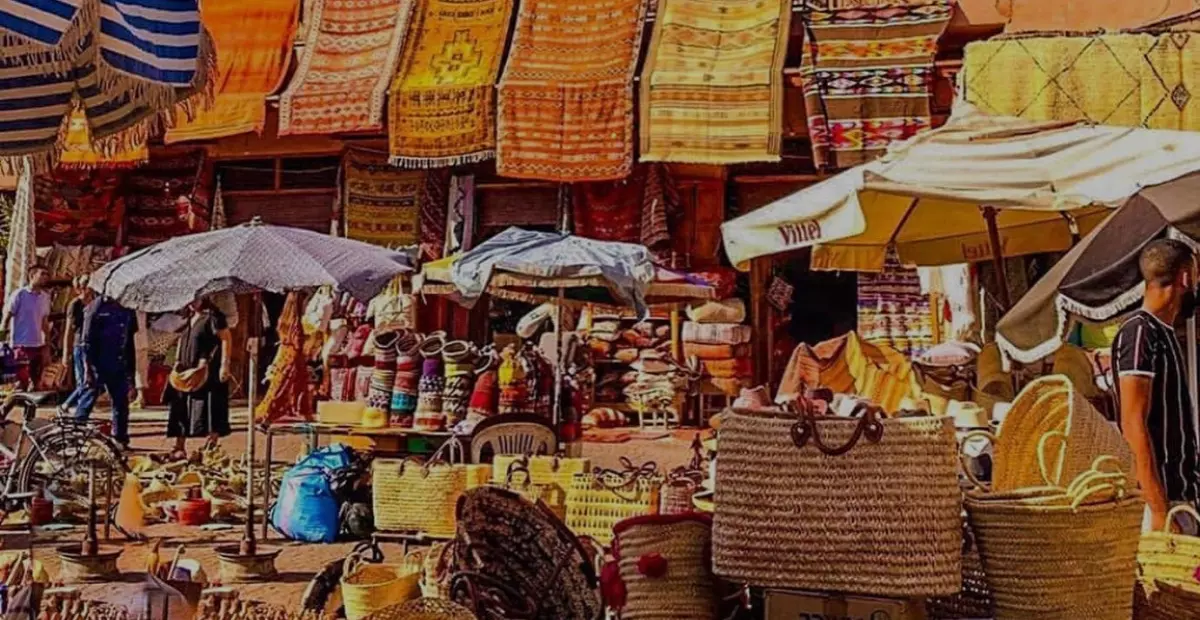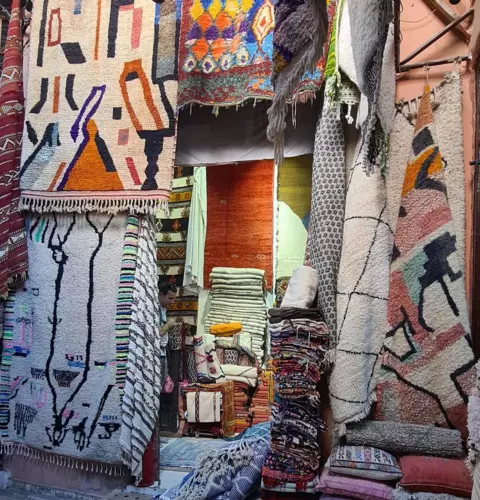
Blog
The Enchanting Beauty of Moroccan Handicrafts
The Moroccan handicrafts are no exception to the country’s enthralling charm. Moroccan handmade goods are a reflection of the country’s diversified heritage and talented artisans and are steeped in rich history and cultural value. Each handmade object reveals a narrative of craftsmanship, history, and the beautiful beauty of Morocco, from elaborately woven carpets to ornate metal lanterns and magnificent ceramics.
- 1. Introduction
- 2. The Rich Cultural Heritage of Moroccan Handicrafts
- 3. The Skilled Artisans Behind Moroccan Handicrafts
- 4. The Timeless Elegance of Moroccan Carpets and Rugs
- 5. The Intricate Beauty of Moroccan Pottery
- 6. The Captivating Art of Moroccan Leatherwork
- 7. The Allure of Moroccan Metalwork
- 8. The Enduring Artistry of Moroccan Woodwork
- 9. The Mesmerizing Art of Moroccan Mosaics
- 10. The Vibrant World of Moroccan Textiles and Embroidery
- 11. The Time-Honored Craft of Moroccan Jewelry
- 12. The Exquisite Craftsmanship of Moroccan Pottery
- 13. The Influence of Moroccan Handicrafts on Global Design
- 14. Preserving Moroccan Handicrafts for Future Generations
- 15. Conclusion
- 16. FAQs
- Plan an Entertaining Moroccan Holiday Now!
1. Introduction
Morocco is known for its stunning handicrafts, owing to its brilliant colors, rich history, and unique cultural heritage. These beautiful artifacts, painstakingly made by experienced artisans, represent the character of the country and bear witness to its rich cultural heritage. Each item conveys a distinct tale of innovation, history, and the timeless beauty of Moroccan workmanship, from exquisite carpets and fascinating ceramics to beautiful metalwork and enchanting mosaics.
2. The Rich Cultural Heritage of Moroccan Handicrafts
a. Diversity of Moroccan Handicrafts
Moroccan handicrafts include a diverse range of art forms, all of which are strongly established in the country’s cultural fabric. Each skill, from textiles and ceramics to leatherwork and jewelry, has its own individuality and regional influence.
b. Historical Significance and Artistic Expression
Moroccan handicrafts have a long history, with certain art forms reaching back centuries. These products not only serve functional needs but also symbolize the Moroccan people’s creative expression and cultural identity.
3. The Skilled Artisans Behind Moroccan Handicrafts
a. Tradition and Craftsmanship
Moroccan handicrafts are passed down from generation to generation, with craftsmen developing their skills and methods from an early age. These artisans’ devotion and passion bring life to each object they produce.
b. Preserving Age-Old Techniques
Despite the passage of time, Moroccan artisans are dedicated to the preservation of age-old skills. This ensures that the craftsmanship and originality of their handicrafts are preserved.
4. The Timeless Elegance of Moroccan Carpets and Rugs
a. Symbolism and Stories Woven into Carpets
Moroccan carpets and rugs are more than simply floor coverings; they are woven stories about their makers’ culture and customs. Intricate patterns and symbols carry deep meanings that have been passed down through centuries.
b. Craftsmanship and Techniques
Moroccan carpet weaving is a labor-intensive procedure that needs accuracy and ability. These masterpieces are skillfully created by artisans, with each thread representing their experience and aesthetic vision.
5. The Intricate Beauty of Moroccan Pottery
a. Traditional Pottery Making
Moroccan pottery is a centuries-old art form that demonstrates the inventiveness of its makers. Pottery-making is profoundly embedded in Moroccan culture, from primitive clay pots to intricate ornamental pieces.
b. Ornate Designs and Functionality
Moroccan pottery incorporates artistic decorations as well as pragmatic functionality. These works are both visually appealing and culturally important because of the confluence of aesthetics and functionality.
6. The Captivating Art of Moroccan Leatherwork
a. Tanning and Coloring Processes
Moroccan leatherwork is well-known for its high-quality materials and vivid hues. Traditional tanning procedures are used, resulting in smooth, pliable leather.
b. Leather Goods as Artistic Creations
Moroccan leatherwork is an excellent kind of workmanship that combines flair and durability, from delicately made bags and belts to luxury footwear.
7. The Allure of Moroccan Metalwork
a. Intricate Metal Engravings
Moroccan metalwork has elaborate engravings and filigree, converting metal into works of beauty.
b. Functional and Decorative Metal Art
Metal artists make useful things like lanterns, trays, and cutlery, as well as beautiful pieces for Moroccan homes and landmarks.
8. The Enduring Artistry of Moroccan Woodwork
a. Traditional Wood Carving Techniques
Moroccan woodwork exhibits the craft of diligent carving, with concepts inspired by the country’s architectural marvels.
b. Architectural Marvels in Wood
Moroccan woodwork covers doors, ceilings, and furniture, offering a timeless elegance to the country’s architecture and interior design.
9. The Mesmerizing Art of Moroccan Mosaics
a. Zellige – The Art of Mosaic Tiling
Moroccan mosaics, known as Zellige, are a stunning style of art that may be seen in mosques, palaces, and old structures.
b. Mosaics in Moroccan Architecture
Zellige, which enriches rooms with brilliant patterns and colors, is a significant aspect of Moroccan architecture.
10. The Vibrant World of Moroccan Textiles and Embroidery
a. Rich Textile Traditions
Moroccan textiles are a colorful and pattern-filled celebration of the country’s many cultural influences.
b. Embroidery as an Art Form
Embroidery on fabrics and clothes is a talent that has been passed down through centuries, bringing beauty and cultural meaning to each piece.
11. The Time-Honored Craft of Moroccan Jewelry
a. Cultural Symbolism in Jewelry
Moroccan jewelry carries a wealth of cultural meaning, frequently expressing identity, protection, and celebration.
b. Masterpieces in Silver and Gold
Moroccan jewelry artisans make complex silver and gold pieces that reflect the country’s creative past.
12. The Exquisite Craftsmanship of Moroccan Pottery
a. Historical Roots and Regional Variations
Moroccan pottery has a lengthy history, with regional variances showcasing the country’s rich artistic talent.
b. Pottery as Cultural Heritage
Moroccan pottery-making is not just an art form, but also an intangible cultural legacy of the country.
13. The Influence of Moroccan Handicrafts on Global Design
a. Inspirations in Contemporary Design
Moroccan handicrafts have had an impact on worldwide design trends, inspiring new designs that combine history and modernity.
b. International Recognition and Demand
Moroccan handicrafts have received international praise for their beauty and skill, resulting in an increase in global demand.
14. Preserving Moroccan Handicrafts for Future Generations
a. Challenges and Sustainable Practices
Moroccan handicrafts encounter obstacles such as modernization and economic constraints. However, attempts are being made to preserve these practices.
b. Empowering Artisans and Communities
Supporting Moroccan artisans helps to maintain not just their trade but also local communities and cultural heritage.
15. Conclusion
Moroccan handicrafts are enchanted by their rich history, cultural value, and the skills of talented artisans. Each handcraft conveys a narrative of innovation, history, and Moroccan craftsmanship’s eternal attraction. These timeless works reflect the history of Morocco’s unique cultural heritage as they continue to capture hearts throughout the world.



16. FAQs
1. Where can I purchase authentic Moroccan handicrafts?
You can by authentic Moroccan handicrafts all across Morocco in traditional souks, artisanal workshops, and specialist craft markets.
2. What makes Moroccan handicrafts unique?
Moroccan handicrafts are unique due to their diverse cultural influences, intricate designs, and the skilled craftsmanship of Moroccan artisans.
3. Are Moroccan handicrafts sustainable and eco-friendly?
Many Moroccan artisans use sustainable and eco-friendly practices in their crafting techniques, preserving the environment while creating beautiful pieces.
4. How can I support Moroccan artisans and their craft?
You can support Moroccan artisans by purchasing handcrafted items directly from them, which contributes to the preservation of their craft and supports local economies.
5. What are some popular Moroccan handicrafts to bring home as souvenirs?
Popular Moroccan handicrafts to bring home as souvenirs include carpets, pottery, leather goods, textiles, and jewelry, each reflecting the unique charm of Moroccan artistry.
Arhhal
Moroccan Travel Expert
Plan an Entertaining Moroccan Holiday Now!
We can help you fit your stay and experience within your allotted budget.
